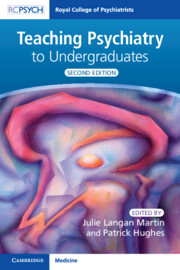Book contents
- Teaching Psychiatry to Undergraduates
- Teaching Psychiatry to Undergraduates
- Copyright page
- Contents
- Contributors
- Section 1 Principles of Medical Education
- Chapter 1.1 The Teacher
- Chapter 1.2 The Curriculum
- Chapter 1.3 Knowledge, Skills and Attitudes
- Chapter 1.4 The Learner
- Section 2 The Undergraduate Psychiatry Curriculum: Planning and Delivery
- Section 3 Clinical Placements in Psychiatry
- Section 4 Formal Teaching
- Section 5 Materials Development
- Section 6 Gathering feedback and quality improvement
- Section 7 Student Welfare
- Section 8 Developing as a medical educator
- Index
- References
Chapter 1.2 - The Curriculum
from Section 1 - Principles of Medical Education
Published online by Cambridge University Press: 12 October 2022
- Teaching Psychiatry to Undergraduates
- Teaching Psychiatry to Undergraduates
- Copyright page
- Contents
- Contributors
- Section 1 Principles of Medical Education
- Chapter 1.1 The Teacher
- Chapter 1.2 The Curriculum
- Chapter 1.3 Knowledge, Skills and Attitudes
- Chapter 1.4 The Learner
- Section 2 The Undergraduate Psychiatry Curriculum: Planning and Delivery
- Section 3 Clinical Placements in Psychiatry
- Section 4 Formal Teaching
- Section 5 Materials Development
- Section 6 Gathering feedback and quality improvement
- Section 7 Student Welfare
- Section 8 Developing as a medical educator
- Index
- References
Summary
This chapter focuses on exploring the concept of a curriculum in the context of medical education and psychiatry. The importance of the interaction between the planned, delivered, and experienced curriculum is considered and the importance of keeping curricula ‘up to date’ is highlighted. The importance of having a clear and transparent curriculum for both students and teachers is considered and the concept of the ‘hidden curriculum’ is introduced.
- Type
- Chapter
- Information
- Teaching Psychiatry to Undergraduates , pp. 6 - 10Publisher: Cambridge University PressPrint publication year: 2022

